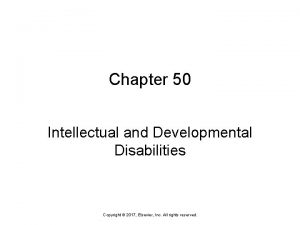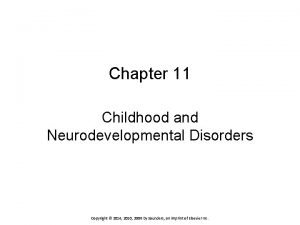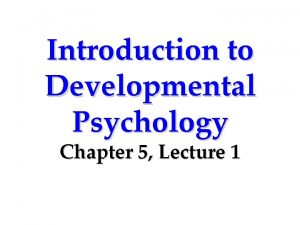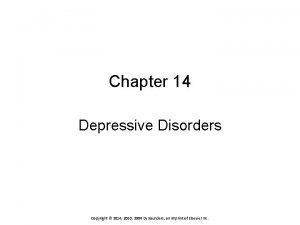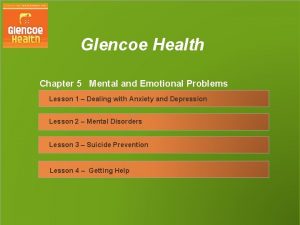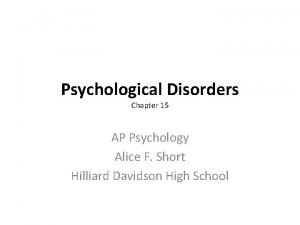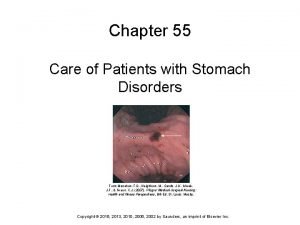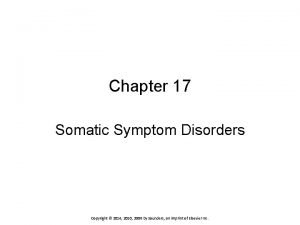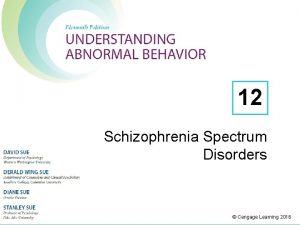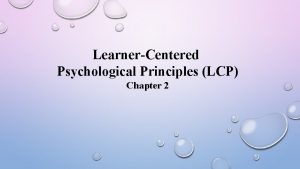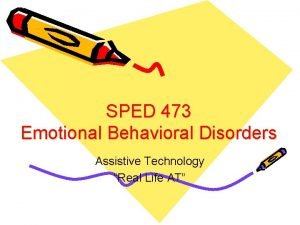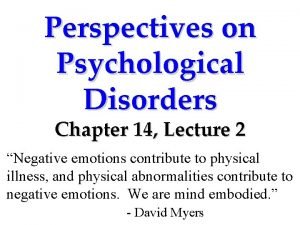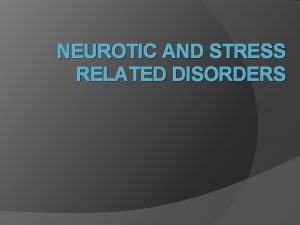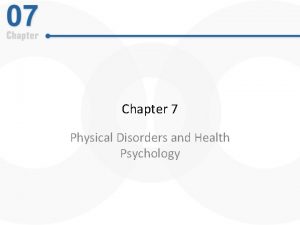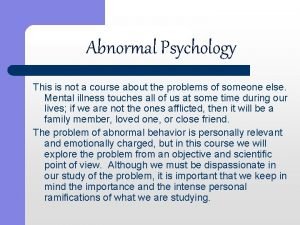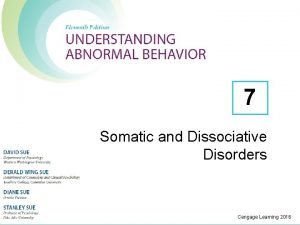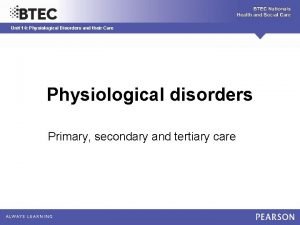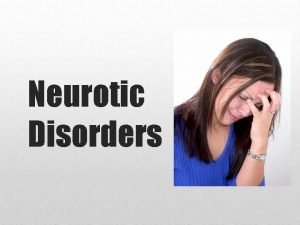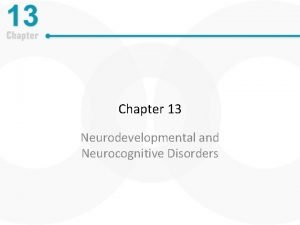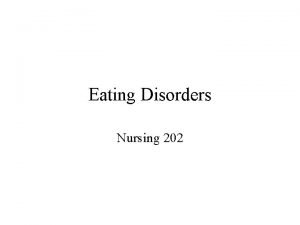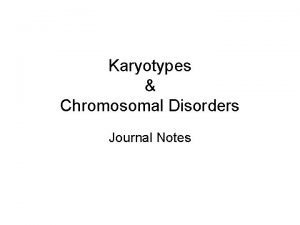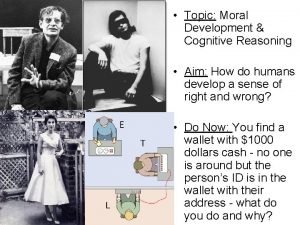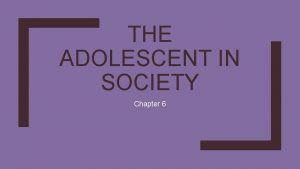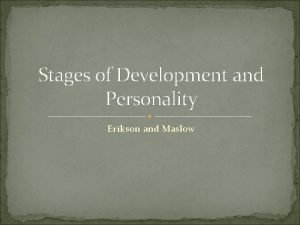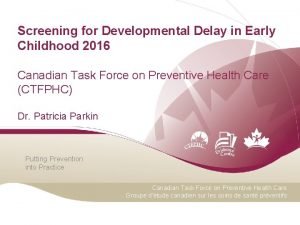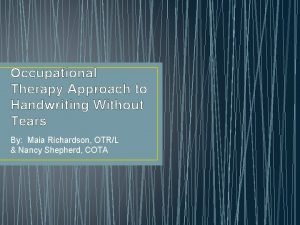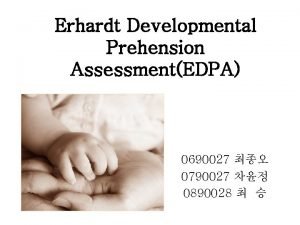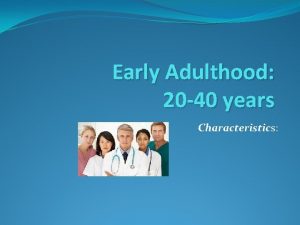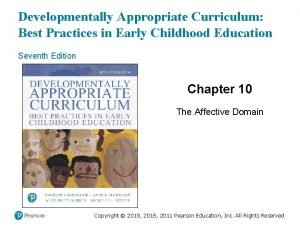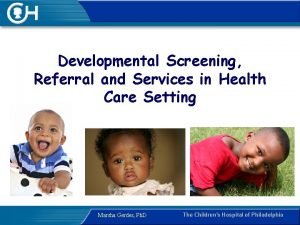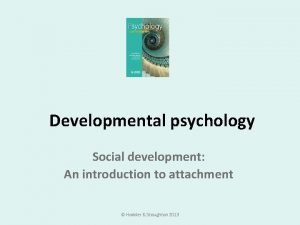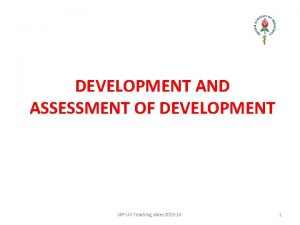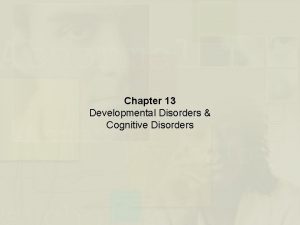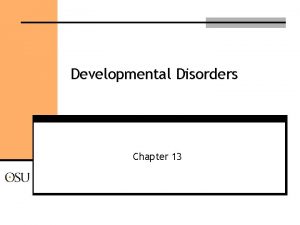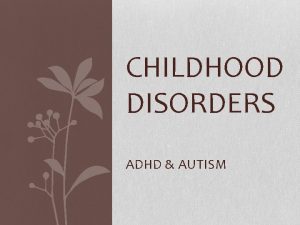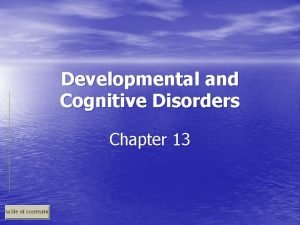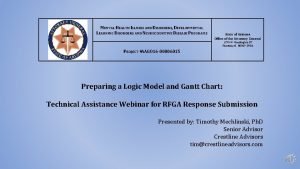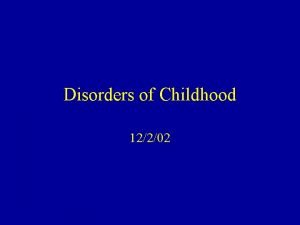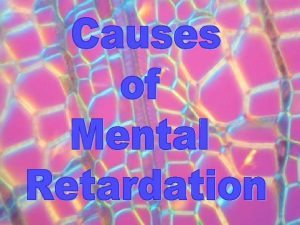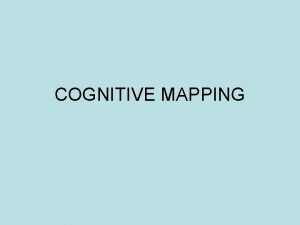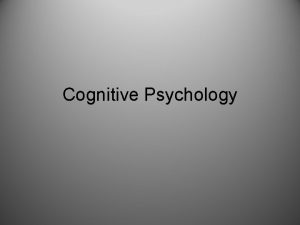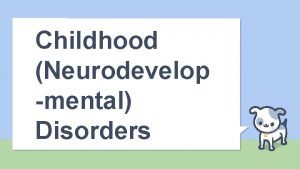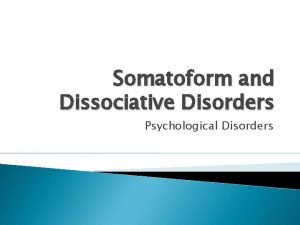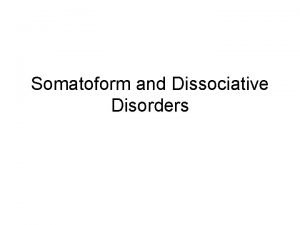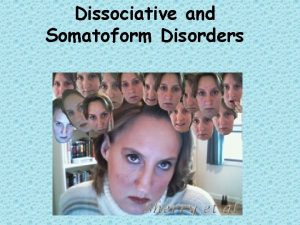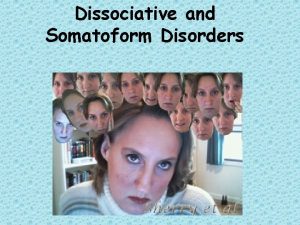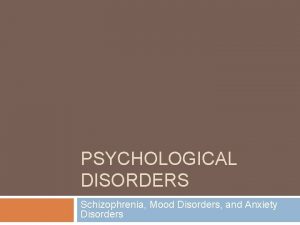Chapter 13 Developmental and Cognitive Disorders Nature of





















































































- Slides: 85

Chapter 13 Developmental and Cognitive Disorders

Nature of Developmental Psychopathology: An Overview • Normal vs. abnormal development • Developmental psychopathology – Study of how disorders arise and change with time – Disruption of early skills can affect later development

Nature of Developmental Psychopathology: An Overview • Developmental disorders – Diagnosed first in infancy, childhood, or adolescence – Attention deficit hyperactivity disorder (ADHD) – Learning disorders – Autism – Mental retardation

Attention Deficit Hyperactivity Disorder (ADHD) • Nature of ADHD – Central features – inattention, overactivity, and impulsivity – Associated with numerous impairments • Behavioral • Cognitive • Social and academic problems

Attention Deficit Hyperactivity Disorder (ADHD) • DSM-IV-TR symptom types – Inattentive type – Hyperactive type – Impulsive type

ADHD: Facts and Statistics • Prevalence – Occurs in 3% - 7% of school-aged children – Symptoms are usually present around age three or four – Children with ADHD have problems as adults • Gender differences – Boys outnumber girls 3: 1 • Cultural factors • Probability of ADHD diagnosis – Greatest in the United States

The Causes of ADHD: Biological Contributions • Genetic contributions – ADHD seems to run in families – DAT 1 - gene have been implicated

The Causes of ADHD: Biological Contributions • Neurobiological contributions – Smaller brain volume – Inactivity of the frontal cortex and basal ganglia – Abnormal frontal lobe development and functioning

The Causes of ADHD: Biological Contributions (continued) • The role of toxins – No evidence that allergens and food additives are causes – Maternal smoking increases risk

The Causes of ADHD: Psychosocial Contributions • Psychosocial factors – Can influence the nature of ADHD – ADHD children are often viewed negatively by others – Constant negative feedback from peers and adults – Peer rejection and resulting social isolation – Such factors foster low self-esteem

Biological Treatment of ADHD • Goal of biological treatments – To reduce impulsivity and hyperactivity and to improve attention • Stimulant medications – Reduce core symptoms in 70% of cases – Examples include Ritalin, Dexedrine

Biological Treatment of ADHD • Other medications with more limited efficacy – Imipramine and clonidine (antihypertensive) – Designer drugs • Effects of medications – Improve compliance and decrease negative behaviors – Do not affect learning and academic performance – Benefits are not lasting following discontinuation

Behavioral and Combined Treatment of ADHD • Behavioral treatment – Reinforcement programs • To increase appropriate behaviors • Decrease inappropriate behaviors – May also involve parent training • Combined bio-psycho-social treatments – Are highly recommended – Superior to medication or behavioral treatments alone

Learning Disorders: An Overview • Scope of learning disorders – Academic problems in reading, mathematics, and writing – Performance substantially below expected levels

Learning Disorders: An Overview • DSM-IV-TR reading disorder – Discrepancy between actual and expected achievement – Performance significantly below age or grade level – Cannot be caused by sensory deficits • DSM-IV-TR mathematics disorder – Achievement below expected performance • DSM-IV-TR disorder of written expression – Achievement below expected performance in writing

Learning Disorders: Statistics • Prevalence of learning disorders – 5 -10% prevalence in the United States – Highest in wealthier regions of the United States – Six million children have been diagnosed – 4 -10% prevalence for reading difficulties – School experience tends to be generally negative


Biological and Psychosocial Causes of Learning Disorders • Genetic and neurobiological contributions – Reading disorder runs in families – Evidence for subtle forms of brain damage is mounting – Overall, contributions are unclear • Psychosocial contributions are largely unknown

Treatment of Learning Disorders • Requires intense educational interventions – Remediation of basic processing problems – Improvement of cognitive skills – Targeting skills to compensate for problem areas • Data support behavioral educational interventions

Pervasive Developmental Disorders: An Overview • Nature of pervasive developmental disorders – Problems occur in language, socialization, and cognition – Pervasive – problems span many life areas • Examples of pervasive developmental disorders – Autistic disorder – Asperger’s syndrome

The Nature of Autistic Disorder: An Overview • Autism – significant impairments – Social interactions and communication – Restricted patterns of behavior, interest, and activities

The Nature of Autistic Disorder: An Overview • Three central DSM-IV-TR features of autism – Qualitative impairment of social interaction – Problems in communication • 50% never acquire useful speech – Restricted patterns of behavior, interests, and activities

Autistic Disorder: Statistics • Prevalence and features of autism – One in every 500 births – More prevalent in females with IQs below 35 – More prevalent in males with higher IQs – Occurs worldwide – Symptoms usually develop before 36 months of age

Autistic Disorder: Statistics • Autism and intellectual functioning – 45%- 60% with autism have average or above average IQs • Reliable indicators of good prognosis – Language ability and IQ

Causes of Autism: Early and More Recent Contributions (continued) • Current understanding of autism – Medical conditions – not always related to autism – Genetic component is largely unclear – Neurobiological evidence of brain damage – Substantially reduced cerebellum size • Psychosocial contributions are unclear


Asperger’s Disorder: Part of the Autistic Spectrum • The nature of Asperger’s disorder – Show significant social impairments – Restricted and repetitive stereotyped behaviors – May be clumsy – Often quite verbal – No severe language and/or cognitive delays

Asperger’s Disorder: Part of the Autistic Spectrum • Prevalence of Asperger’s disorder – Often under diagnosed – Affects about one - two persons per 10, 000 people – More often in boys that girls • Causes of Asperger’s disorder are somewhat unclear

Treatment of Pervasive Developmental Disorders: Example of Autism • Psychosocial “behavioral” treatments – Skill building – Reduction of problem behaviors – Target communication and language problems – Address socialization deficits – Early intervention is critical

Treatment of Pervasive Developmental Disorders: Example of Autism • Biological and medical treatments are unavailable • Integrated treatments: The preferred model – Focus on children, their families, schools, and home – Build in appropriate community and social support

Intellectual disability (ID): An Overview • Nature of mental retardation – Disorder of childhood – Below-average intellectual and adaptive functioning – Range of impairment varies greatly across persons

Intellectual disability (ID): An Overview • DSM-IV-TR criteria – Significantly sub-average intellectual functioning – Deficits or impairments in present adaptive functioning – Must be evident before the person is 18 years of age

DSM-IV-TR Levels of Intellectual disability (ID) • Mild ID – IQ score between 50 or 55 and 70 • Moderate ID – IQ range of 35 -40 to 50 -55 • Severe ID – IQs ranging from 20 -25 up to 35 -40 • Profound ID – IQ scores below 20 -25

Other Classification Systems for Intellectual disability (ID) • American Association of Mental Retardation (AAID) – Defines ID based on levels of assistance required – Levels of assistance • Intermittent, limited, extensive, pervasive

Other Classification Systems for Intellectual disability (ID) • Classification of ID in educational systems – Educable (IQ of 50 to 70 -75) – Trainable (IQ of 30 to 50) – Severe (IQ below 30) • Implications of different ID classification systems

Intellectual disability (ID): Some Facts and Statistics • Prevalence – About 1 -3% of the general population – 90% are labeled with mild intellectual disability • Course of ID – Tends to be chronic – Prognosis varies greatly from person to person

Causes of Intellectual disability (ID): Biological Contributions • Hundreds of known causes – Environmental – deprivation, abuse – Prenatal – exposure to disease or a drug/toxin – Perinatal – difficulties during labor – Postnatal – head injury

Causes of Intellectual disability (ID): Biological Contributions • Genetic research – Multiple genes, and at times single genes • Chromosomal abnormalities – Down syndrome and fragile X syndrome – PKU – Lesch-Nyhan syndrome

Causes of Intellectual disability (ID): Biological Contributions • Down syndrome – Maternal age and risk of having a Down’s baby – Amniocentesis – Chorionic villus sampling (CVS)


• Cultural-familial intellectual disability – Believed to cause about 75% of ID cases – Is the least understood – Associated with • Mild levels of retardation on IQ tests • Good adaptive skills


Treatment of Intellectual disability (ID) • Parallels treatment of pervasive developmental disorders • Teach needed skills – To foster productivity – To foster independence – Educational and behavioral management – Living and self-care skills via task analysis – Communication training – often most challenging

Treatment of Intellectual disability (ID) • Community and supportive interventions – Persons with ID can benefit from such interventions

Summary of Developmental Disorders • Developmental psychopathology • Attention deficit hyperactivity disorder – Deficits in attention, hyperactivity, or impulsivity • Learning disorders – Deficits in performance below expectations

Summary of Developmental Disorders • Pervasive developmental disorder – All share deficits in language, socialization, and cognition • Intellectual disability – Sub-average IQ, deficits in adaptive functioning – Onset before age 18 • Prevention and early intervention are critical

Nature of Cognitive Disorders: An Overview • Perspectives on cognitive disorders – Affect learning, memory, and consciousness – Most develop later in life • Three classes of cognitive disorders – Delirium – temporary confusion and disorientation – Dementia – marked by broad cognitive deterioration – Amnestic disorders – memory dysfunctions

Nature of Cognitive Disorders: An Overview • Shifting DSM perspectives – From “organic” mental disorders to “cognitive” disorders – Broad impairments in cognitive functioning – Profound changes in behavior and personality

Delirium: An Overview • Nature of delirium – Central features – impaired consciousness and cognition – Develops rapidly over several hours or days – Appear confused, disoriented, and inattentive – Marked memory and language deficits

Delirium: An Overview (continued) • Facts and statistics – Affects up 30% of persons in acute care facilities – Most prevalent in older adults • Those undergoing medical procedures • AIDS patients and cancer patients – Full recovery often occurs within several weeks

Medical Conditions Related to Delirium • Medical conditions – Drug intoxication, poisons, withdrawal from drugs – Infections – Head injury and several forms of brain trauma – Sleep deprivation, immobility, and excessive stress

Medical Conditions Related to Delirium • DSM-IV-TR subtypes of delirium – Delirium due to a general medical condition – Substance-induced delirium – Delirium due to multiple etiologies – Delirium not otherwise specified

Treatment and Prevention of Delirium • Treatment – Attention to precipitating medical problems – Psychosocial interventions include reassurance • Focus on coping strategies • Inclusion of patients in treatment decisions • Prevention – Address proper medical care for illnesses – Address proper use and adherence to therapeutic drugs

Dementia: An Overview • Nature of dementia – Gradual deterioration of brain functioning – Deterioration in judgment and memory – Deterioration in language / advanced cognitive processes – Has many causes and may be irreversible

Dementia: Initial and Later Stages • Initial stages – Memory and visuospatial skills impairments – Agnosia – inability to recognize and name objects – Facial agnosia – inability to recognize familiar faces – Other symptoms • Delusions, apathy, depression, agitation, aggression

Dementia: Initial and Later Stages • Later stages – Cognitive functioning continues to deteriorate – Total support is needed to carry out day-to-day activities – Death due to inactivity and onset of other illnesses

DSM-IV-TR Classes of Dementia • Dementia of the Alzheimer’s type • Vascular dementia • Dementia due to other general medical conditions • Substance-induced persisting dementia • Dementia due to multiple etiologies • Dementia not otherwise specified

Dementia of the Alzheimer’s Type: An Overview • DSM-IV-TR criteria and clinical features – Multiple cognitive deficits – Develop gradually and steadily – Memory, orientation, judgment, and reasoning deficits – Additional symptoms may include • Agitation, confusion, or combativeness • Depression and/or anxiety – “Sundowner syndrome”

Dementia of the Alzheimer’s Type: Extent of Deficits • Range of cognitive deficits – Aphasia – difficulty with language – Apraxia – impaired motor functioning – Agnosia – failure to recognize objects – Difficulties with • • Planning Organizing Sequencing Abstracting information – Negative impact on social and occupational functioning

Dementia of the Alzheimer’s Type: Extent of Deficits • Until recently an autopsy is required for a definitive diagnosis

Alzheimer’s Disease: Some Facts and Statistics • Nature and progression of the disease – Deterioration is slow during the early and later stages – Deterioration is rapid during middle stages – Average survival time is about eight years – Onset usually occurs in the 60 s or 70 s

Alzheimer’s Disease: Some Facts and Statistics • Prevalence of Alzheimer’s disease – Prevalence greater in • Poorly educated persons – Prevalence rates are low in some ethnic groups

Vascular Dementia: An Overview • Nature of vascular dementia – Caused by blockage or damage to blood vessels – Second leading cause of dementia next to Alzheimer’s – Onset is often sudden (e. g. , stroke) – Patterns of impairment are variable – Most require formal care in later stages

Vascular Dementia: An Overview • DSM-IV-TR criteria and incidence – Cognitive disturbances – identical to dementia – Obvious neurological signs of brain tissue damage – Prevalence 1. 5% in people 70 and 15% for people over 80 – Risk slightly higher in men

Other Causes of Dementia: Head Trauma • Head trauma – accidents are leading cause – Memory loss is the most common symptom

Other Causes of Dementia: HIV-1 • HIV-1 – Causes neurological impairments and dementia – Cognitive slowness, impaired attention, and forgetfulness – Apathy and social withdrawal

Other Causes of Dementia: Parkinson’s Disease • Parkinson’s disease – degenerative brain disorder – Affects about one out of 1, 000 people worldwide – Motor problems – central feature of this disorder • Caused by damage to dopamine pathways – 75% survival rate for 10 years

Other Causes of Dementia: Huntington’s • Huntington’s disease – Genetic autosomal dominant disorder – Manifests initially as chorea, usually later in life – About 20 -80% display dementia – Dementia follows a subcortical pattern

Other Causes of Dementia: Pick’s Disease • Pick’s disease – Rare neurological condition – Produces a cortical dementia like Alzheimer’s – Also occurs later in life (around 40 s or 50 s) – Little is known about what causes this disease

Other Dementias: Creutzfeldt-Jakob Disease • Creutzfeldt-Jakob disease – Affects one out of 1, 000 persons – Linked to mad cow disease

Other Dementias: Substance-Induced Dementia • Substance-induced persisting dementia – Results from drug use in combination with poor diet – Several drugs can lead to symptoms of dementia – Resulting brain damage may be permanent – Dementia is similar to that of Alzheimer’s – Deficits may include • Aphasia, apraxia, agnosia • Disturbed executive functioning

Causes of Dementia: The Example of Alzheimer’s Disease • Early and largely unsupported views – Implicated smoking, negative correlation

Causes of Dementia: The Example of Alzheimer’s Disease • Current neurobiological findings – Neurofibrillary tangles – Amyloid plaques – The role of deterministic genes • Beta-amyloid precursor gene • Presenilin-1 and Presenilin-2 genes – The role of susceptibility genes - Apo. E 4 gene – Brains of Alzheimer’s patients tend to atrophy

Causes of Dementia: The Example of Alzheimer’s Disease • Current neurobiological findings – Multiple genes are involved in Alzheimer’s disease – Chromosomes 21, 19, 14, 12, – Chromosome 14 • Associated with early onset Alzheimer’s – Chromosome 19 • Associated with late onset Alzheimer’s

The Contributions of Psychosocial Factors in Dementia • Psychosocial factors – Do not cause dementia directly – May influence onset and course – Lifestyle factors – drug use, diet, exercise, stress – Cultural factors • Risk for certain conditions vary by ethnicity and class – Psychosocial factors • Educational attainment, coping skills, social support

Medical and Psychosocial Treatment of Dementia • Medical treatment: Best if enacted early – Few exist for most types of dementias – Most attempt to slow progression of deterioration – Do not stop progression of dementia – Caregiver can be negatively impacted

Medical and Psychosocial Treatment of Dementia • Psychosocial treatments – aims – To enhance lives of patients and their families – To teach compensatory skills – To use memory enhancement devices, if needed – Psychosocial interventions appear to focus on caregivers

Prevention of Dementia • Reducing risk of dementia in older adults – Estrogen-replacement therapy – Proper treatment of cardiovascular diseases – Use of anti-inflammatory medications – Control blood pressure and lead an active social life • Other targets of prevention efforts – Increasing safety behaviors to reduce head trauma – Reducing exposure to neurotoxins and use of drugs

Amnestic Disorder: An Overview • Nature of amnestic disorder – Circumscribed loss of memory – Inability to transfer information into long-term memory – No loss of other high-level cognitive functions

Amnestic Disorder: An Overview • Causes may include – Medical conditions, head trauma, or long-term drug use • DSM-IV-TR criteria – Inability to • Learn new information or recall learned information – Significant impairment in functioning

Amnestic Disorder: An Overview • The example of Wernicke-Korsakoff syndrome – Damage to the thalamus – Thiamine (vitamin B-1) deficiency – Resulting from stroke or chronic heavy alcohol use • Prevention – Use of thiamine supplements with heavy drinkers • Research on amnestic disorders is scant

Summary of Cognitive Disorders • Cognitive disorders span a range of deficits – Affect attention, memory, language, and motor behavior – Causes include • Medical conditions • Drug use • Environmental factors

Summary of Cognitive Disorders • Most result in progressive deterioration of functioning • Few treatments exist to reverse damage and deficits

Dementia: Statistics • Onset and prevalence – Can occur at any age, but most common in the elderly – Affects over 10% of persons 85 years and older • Incidence of dementia – Affects 8. 5% of those 85 and older – Rates seem to double with every five years of age

Dementia: Facts and Statistics • Gender and sociocultural factors – Occurs equally in men and women – Occurs equally across educational level and social class
 Name the five lesions associated with hiv/aids chapter 17
Name the five lesions associated with hiv/aids chapter 17 Cognitive and non cognitive religious language
Cognitive and non cognitive religious language Chapter 50 intellectual and developmental disabilities
Chapter 50 intellectual and developmental disabilities Nature and nature's law lay hid in night meaning
Nature and nature's law lay hid in night meaning Chapter 8 skin disorders and diseases review questions
Chapter 8 skin disorders and diseases review questions Chapter 6 musculoskeletal system
Chapter 6 musculoskeletal system Chapter 46 digestive and endocrine disorders
Chapter 46 digestive and endocrine disorders Somatic symptom disorder
Somatic symptom disorder Chapter 29 endocrine and metabolic disorders
Chapter 29 endocrine and metabolic disorders Chapter 21 mental health diseases and disorders
Chapter 21 mental health diseases and disorders Chapter 18 eating and feeding disorders
Chapter 18 eating and feeding disorders Chapter 17 reproductive system diseases and disorders
Chapter 17 reproductive system diseases and disorders Chapter 15 nervous system diseases and disorders
Chapter 15 nervous system diseases and disorders Chapter 15 anxiety and obsessive-compulsive disorders
Chapter 15 anxiety and obsessive-compulsive disorders Chapter 11 childhood and neurodevelopmental disorders
Chapter 11 childhood and neurodevelopmental disorders Chapter 8 skin disorders and diseases
Chapter 8 skin disorders and diseases When performing a hand skin and nail analysis
When performing a hand skin and nail analysis Nail diseases and disorders milady
Nail diseases and disorders milady Cardiovascular system diseases and disorders chapter 8
Cardiovascular system diseases and disorders chapter 8 Milady chapter 8 skin disorders and diseases
Milady chapter 8 skin disorders and diseases Chapter 47 urinary and reproductive disorders
Chapter 47 urinary and reproductive disorders Managing weight and eating behaviors
Managing weight and eating behaviors 10 diseases of lymphatic system
10 diseases of lymphatic system Chapter 11 developmental theories
Chapter 11 developmental theories Chapter 5 developmental psychology
Chapter 5 developmental psychology Determinace lidské psychiky
Determinace lidské psychiky Chapter 18 psychological disorders review worksheet
Chapter 18 psychological disorders review worksheet Chapter 11 genetic disorders concept mapping
Chapter 11 genetic disorders concept mapping Chapter 18 psychological disorders
Chapter 18 psychological disorders Chapter 14 psychological disorders
Chapter 14 psychological disorders Chapter 14 depressive disorders
Chapter 14 depressive disorders Chapter 5 glencoe health answers
Chapter 5 glencoe health answers Chapter 5 lesson 4 getting help answer key
Chapter 5 lesson 4 getting help answer key Chapter 14 psychological disorders
Chapter 14 psychological disorders Ap psychology chapter 15
Ap psychology chapter 15 Chapter 55 care of patients with stomach disorders
Chapter 55 care of patients with stomach disorders Chapter 17 somatic symptom disorders
Chapter 17 somatic symptom disorders Chapter 12 schizophrenia spectrum disorders
Chapter 12 schizophrenia spectrum disorders Chapter 12 schizophrenia spectrum disorders
Chapter 12 schizophrenia spectrum disorders Chapter 5 cognitive development in infancy and toddlerhood
Chapter 5 cognitive development in infancy and toddlerhood Learner centered psychological principles
Learner centered psychological principles Early childhood is ____ for language learning
Early childhood is ____ for language learning Unit 14 physiological disorders examples
Unit 14 physiological disorders examples Bipolar and other related disorders
Bipolar and other related disorders Bipolar and other related disorders
Bipolar and other related disorders Assistive technology for emotional disturbance
Assistive technology for emotional disturbance Puberty and autism spectrum disorders
Puberty and autism spectrum disorders Axis 1 and axis 2 disorders
Axis 1 and axis 2 disorders Neurotic, stress-related and somatoform disorders
Neurotic, stress-related and somatoform disorders Physical disorders and health psychology
Physical disorders and health psychology Personality disorder vs mental illness
Personality disorder vs mental illness Axis 1 and 2 disorders
Axis 1 and 2 disorders Cengage
Cengage Unit 14 physiological disorders and their care
Unit 14 physiological disorders and their care Neurotic personality disorder
Neurotic personality disorder Neurocognitive disorders
Neurocognitive disorders Albinism and phenylketonuria are disorders due to
Albinism and phenylketonuria are disorders due to Hypothalamus eating disorders
Hypothalamus eating disorders Difference between mendelian and chromosomal disorders
Difference between mendelian and chromosomal disorders Ap psychology unit 9
Ap psychology unit 9 Lawrence kohlberg developmental psychology
Lawrence kohlberg developmental psychology Ego centerism
Ego centerism What does the theory of evolution state
What does the theory of evolution state Carl glickman
Carl glickman Adolescence example
Adolescence example Developmental milestones بالعربي
Developmental milestones بالعربي Piramide de erikson
Piramide de erikson Da form 4856
Da form 4856 Denver developmental screening test
Denver developmental screening test Research methods in developmental psychology
Research methods in developmental psychology Handwriting without tears occupational therapy
Handwriting without tears occupational therapy Developmental anatomy
Developmental anatomy Gestalt
Gestalt Gesell incomplete man test
Gesell incomplete man test Developmental homologies
Developmental homologies Erikson developmental stages
Erikson developmental stages Edpa 평가지
Edpa 평가지 Early adulthood characteristics
Early adulthood characteristics Early adulthood age erikson
Early adulthood age erikson Developmentally appropriate curriculum 7th edition
Developmentally appropriate curriculum 7th edition Developmental theories
Developmental theories Developmental sequences in language acquisition
Developmental sequences in language acquisition Developmental screening vs surveillance
Developmental screening vs surveillance Attachment theory in psychology
Attachment theory in psychology Developmental research design
Developmental research design Iap teaching slides
Iap teaching slides


